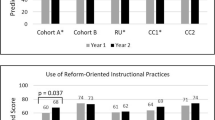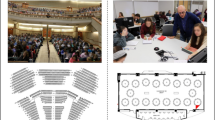Abstract
A student-choice model course redesign was used to counteract a large increase in student enrollment, improve the quality of instruction, and preserve student success. This model is an instructional technique that allows students to choose how to engage in a course. Using this model in a first-semester college-level general chemistry course, online options were created to augment the traditional face-to-face course. The traditional lecture time was reduced from 3 to 2 h per week while the traditional recitation time was increased from 1 to 2 h per week. The recitation component was also transitioned from a supplemental lecture session into a problem-solving active-learning component. A mandatory rotation between face-to-face and online options at the start of the semester was necessary to assist students in making an informed choice about what options best fit their needs. Pre- and post-redesign student performance data (2008–2016) and post-redesign student enrollment data (2012–2016) were evaluated. Course performance was maintained and often improved in post-redesign years, and was generally equivalent in the different course combinations.







Similar content being viewed by others
References
Barnes, K., Marateo, R. C., & Ferris, S. P. (2007). Teaching and learning with the net generation. Innovate: Journal of Online Education, 3(4), Article 1), 1–8.
Bruff, D. (2009). Teaching with classroom response systems: creating active learning environments. Hoboken: Wiley.
Carlson, S. (2005). The net generation goes to college. The Chronicle of Higher Education, 52(7), A34.
Charlton, B. G. (2006). Lectures are such an effective teaching method because they exploit evolved human psychology to improve learning. Medical Hypothesis, 67(6), 1261–1265.
Duncan, D. (2005). Clickers in the classroom: how to enhance science teaching using classroom response systems. Upper Saddle River: Pearson.
Dziuban, C., Moskal, P., & Hartman, J. (2005). Higher education, blended learning, and the generations: knowledge is power-no more. In J. Bourne & J. C. Moore (Eds.), Elements of quality online education: engaging communities (pp. 85–100). Needham: Sloan Center for Online Education.
Gasiewski, J. A., Eagan, M. K., Garcia, G. A., Hurtado, S., & Chang, M. J. (2012). From gatekeeping to engagement: a multicontextual, mixed method study of student academic engagement in introductory STEM courses. Research in Higher Education, 53(2), 229–261.
Goldenberg, E. P. (2000). Thinking (and talking) about technology in math classrooms. Issues in Mathematics Education. The K-12 Mathematics Curriculum Center. http://mcc.edc.org/pdf/iss_tech.pdf. Accessed November 1, 2018.
Harrington, A. M. (2010). Problematizing the hybrid classroom for ESL/EFL students. The Electronic Journal for English as a Second Language, 14, Article 3, 1–13.
Hart, A. G., Stafford, R., & Goodenough, A. E. (2011). Bridging the lecturer/student divide: the role of residential field courses. Bioscience Education, 17(1), 1–5.
Inglis, M., Palipana, A., Trenholm, S., & Ward, J. (2011). Individual differences in students’ use of optional learning resources. Journal of Computer Assisted Learning, 27(6), 490–502.
Iyengar, S. (2007). To read or not to read: a question of national consequence. National Endowment for the Arts. Research Report #47. https://www.arts.gov/sites/default/files/ToRead.pdf. Accessed November 1, 2018.
Lai, K.-W., Khaddage, F., & Knezek, G. (2013). Blending student technology experiences in formal and informal learning. Journal of Computer Assisted Learning, 29(5), 414–425.
Lake, D. A. (2001). Student performance and perceptions of a lecture-based course compared with the same course utilizing group discussion. Physical Therapy, 81(3), 896–902.
Lei, J. (2010). Quantity versus quality: a new approach to examine the relationship between technology use and student outcomes. British Journal of Educational Technology, 41(3), 455–472.
Mazur, E. (1997). Peer instruction: a user’s manual, series in educational innovation. Upper Saddle River: Prentice Hall.
McDowell, T. R., Schmittzehe, E. T., Woelk, K., & Collier, H. (2016). Fostering a positive collaborative learning experience in an optional student success program. Journal of Modern Education Review, 6(8), 561–567.
Mervis, J. (2010). Better intro courses seen as key to reducing attrition of STEM majors. Science, 330(6002), 306–306.
Moog, R. S., & Spencer, J. N. (2008). Process oriented guided inquiry learning. Oxford: Oxford University Press.
Quitadamo, I. J., Brahler, C. J., & Crouch, G. J. (2009). Peer-led team learning: a prospective method for increasing critical thinking in undergraduate science courses. Science Education, 18(1), 29–39.
Sawatsky, A. P., Berlacher, K., & Granieri, R. (2014). Using an ACTIVE teaching format versus a standard lecture format for increasing resident interaction and knowledge achievement during noon conference: a prospective, controlled study. BMC Medical Education, 14(1), Article 129), 1–6.
Silverthorn, D. U. (2006). Teaching and learning in the interactive classroom. Advances in Physiology Education, 30(4), 135–140.
Sparrow, B., Liu, J., & Wegner, D. M. (2011). Google effects on memory: cognitive consequences of having information at our fingertips. Science, 333(6043), 776–778.
Talbert, R. (2012). Four things lecture is good for, The Chronicle 02/13/2012 http://www.chronicle.com/blognetwork/castingoutnines/2012/02/13/four-things-lecture-is-good-for/. Accessed November 1, 2018.
Twigg, C. A. (2003). Improving learning and reducing costs: new models for online learning. Education Review, 38, 28–38.
Weinreich, H., Obendorf, H., Herder, E., & Mayer, M. (2008). Not quite the average: an empirical study of web use. ACM Transactions on the Web (TWEB), 2(1), Article 5), 1–31.
Wood, W. B., & Tanner, K. D. (2012). The role of the lecturer as tutor: doing what effective tutors do in a large lecture class. CBE Life Sciences Education, 11(1), 3–9.
Acknowledgements
Guidance in course redesign was provided by the National Center for Academic Transformation. The authors thank the Missouri University of Science & Technology’s Educational Technology Division for assistance with the implementation of necessary teaching technology.
Funding
Funding for this project was provided to KW by the State of Missouri (Governor’s Large-Enrollment Multi-Section Redesign Initiative), by the University of Missouri System (Technology-supported Active-learning Course Redesign), and by the Missouri S&T Provost Office (General Chemistry I Buffet-Model Whole-Course Redesign), and to ES by a Missouri S&T Provost’s eFellows Grant (Tailoring Resources and Increasing Accessibility for Students in General Chemistry). This work was funded by the Missouri Learning Commons, the University of Missouri System, the Office of the Provost at Missouri University of Science & Technology, and the Missouri University of Science and Technology Chemistry Department.
Author information
Authors and Affiliations
Corresponding author
Ethics declarations
Conflict of Interest
The authors declare that they have no conflict of interest.
Ethical Approval
The research uses large-scale secondary datasets. No data were directly collected from human participants, and data are not traceable to individual participants. All procedures performed in the studies involving human participants were in accordance with the ethical standards of the institutional and/or national research committee.
Additional information
Publisher’s Note
Springer Nature remains neutral with regard to jurisdictional claims in published maps and institutional affiliations.
Rights and permissions
About this article
Cite this article
McDowell, T.R., Schmittzehe, E.T., Duerden, A.J. et al. A Student-Choice Model to Address Diverse Needs and Promote Active Learning. J Sci Educ Technol 28, 321–328 (2019). https://doi.org/10.1007/s10956-019-9768-2
Published:
Issue Date:
DOI: https://doi.org/10.1007/s10956-019-9768-2




